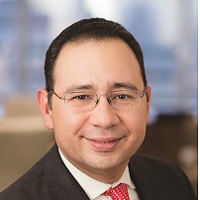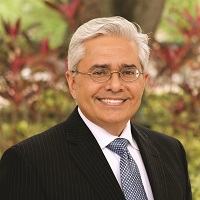EB5 Investors Magazine is pleased to announce the Top 15 Corporate and Securities Attorneys. To be eligible, distinguished attorneys needed to primarily draft offering documents for EB-5 financing.
For more information or to contact any of these professionals, we invite you to view their listings at www.EB5Investors.com/directories.
ROGELIO CARRASQUILLO
CARRASQUILLO LAW GROUP P.C.

Rogelio “Roy” Carrasquillo is the managing shareholder of Carrasquillo Law Group P.C. and chair of its EB-5 immigrant investor program services and compliance and securities practices. Carrasquillo represents public and private clients using EB-5 as a source of capital, filing for EB-5 regional center designation, investors evaluating their redeployment options, and developers seeking to raise EB-5 capital. He is experienced in public-private partnership projects using EB-5 funds and other economic and tax incentives. Carrasquillo is a frequent speaker and writer on EB-5 and securities law matters. He is a graduate of Georgetown University and University of Pennsylvania Law School and is admitted to practice in New York and Puerto Rico.
What trends are you seeing in the EB-5 industry?
We saw a decrease in the number of projects trying to incorporate EB-5 financing at the end of 2019. We are now working with our clients to adapt to the new rules. We are seeing successful raises using non-traditional structures with higher investment amounts and higher returns. Projects are incorporating various sources of funds to their capital stack, including tax credits, grants and bonds. Investors and developers are also seeing EB-5 financing as an additional benefit and not as the sole purpose or financing source of the projects. We continue to see a focus on alternative markets such as Latin America, where investors want to be more involved in the projects and look for a higher return of investment.
How are you handling the issue of redeployment?
We continue to work with our clients to ensure that their EB-5 offering documents cover redeployment both from a securities and an immigration points of view. We try to reach a balance between protecting the investors, providing the right disclosures, and providing the developer the highest level of flexibility in the process of redeployment. We are also assisting investors who are being faced with the issue of redeployment as their projects reach maturity to ensure that their rights are protected during the process and to avoid unnecessary delays to the return of their investment.
RONALD FIELDSTONE
SAUL EWING ARNSTEIN & LEHR LLP

Ronald Fieldstone, chair of Saul Ewing Arnstein & Lehr LLP’s Global Immigration and Foreign Investment Group and head of the firm’s Opportunity Zone Group, practices primarily in the areas of corporate/securities and taxation law. Fieldstone has been serving as corporate/securities counsel for multifaceted industries involving EB-5 immigrant visa investor offerings. He represents developers and regional centers in EB-5 matters, currently handling more than 350 EB-5 projects with combined capital raise of nearly $8 billion. He prepares private placement memoranda and related documents. Fieldstone frequently lectures and publishes about the subject of EB-5 corporate/securities. He obtained his bachelor’s, MBA and Juris Doctor from the University of Pennsylvania.
What trends are you seeing in the EB-5 industry?
The EB-5 industry is going through a major transition due to the uncertainty in legislation, retrogression and a shift in marketing outlets. We will experience transactions becoming more economically attractive to the EB-5 investors, with a more meaningful rate of return combined with far more equity from developers and greater transparency in the offering elements and marketing materials. Marginal projects will not survive in the new market conditions.
How are you handling the issue of redeployment?
Since 2009, the industry progressed. I became involved in all facets of the process, including the securities law issues making numerous regulatory requirements that had a significant impact on the structuring of transactions. I needed to become a quasi-expert in the immigration components of the program to better understand the securities and corporate issues. I used this background to also undertake work related to SEC investigations, tax planning matters and the real estate component of the loan models. I have enjoyed the multidisciplinary aspects of the program.
CATHERINE D. HOLMES
JMBM

Catherine D. Holmes is the chair of JMBM’s Investment Capital Law Group. She has practiced law at JMBM for over 35 years, focusing on investment capital and business transactions. Holmes helps clients worldwide to raise, invest and manage capital from U.S. and non-U.S. investors. She has represented more than 100 real estate developers in obtaining financing through the EB-5 immigrant investor visa program for the development of hotels, multifamily and mixed-use developments through the U.S. Holmes has extensive experience in the hospitality industry. She also handles business formations, private investment fund offering, business and regulatory matters.
What trends are you seeing in the EB-5 industry?
The long waiting periods for EB-5 investors from China and the increase in the minimum investment amount have substantially reduced the overall demand for EB-5 investments. The regulatory changes in the requirements for a targeted employment area have radically reduced the number of projects that are able to qualify for the lower minimum investment amount. This does not appear to have increased the number of projects in rural areas, though additional time will be required to determine the effect. It will take at least another 12 months to evaluate the long-term effect of the new regulations on the EB-5 market.
How are you handling the issue of redeployment?
The safest form of redeployment from the standpoint of USCIS policy and the expectations of EB-5 investors may be a redeployment in a project that is substantially similar to the original EB-5 investment with the same developer as the original EB-5 investment. Because of the extended waiting periods for EB-5 investors from mainland China, some EB-5 investors are electing to withdraw their visa petitions and absolve their investment of the “at risk” requirement. Even though an NCE may not be required to repay those withdrawing EB-5 investors, the NCE should use proceeds of repayment of their initial investment to repay the withdrawing EB-5 investors.
DOUG HAUER
MINTZ, LEVIN, COHN, FERRIS, GLOVSKY AND POPEO, P.C.

Doug Hauer is a member in Mintz’s corporate & securities practice and immigration practice. He is a noted authority on the EB-5 investor visa program, which gives developers a path for securing capital for real estate and hospitality projects. His familiarity with the program makes him an essential resource for companies looking for financing from offshore sources. International entrepreneurs and companies also rely on him when launching a business in the U.S. Hauer teaches graduate courses in professional responsibility and ethics and immigration law at Boston University School of Law. He is a founding member of the EB-5 Securities Law Roundtable.
What trends are you seeing in the EB-5 industry?
The trends all point to a cooled-off marketplace. A sort of irreversible climate change has set in on EB-5. Fewer developers with the capability to participate in EB-5 transactions are willing to take on the reputational risks and costs, or the exposure that comes with amplified risks of government scrutiny and investigations. There is less investor-side demand, because of increased investment minimums and uncertainty with visa numbers. Developers and institutional investors in deals are asking more questions on the costs and exposure with winding up EB-5 investment vehicles earlier than anticipated.
How are you handling the issue of redeployment?
The first thing I tell clients is that redeployment is a fiction. We need to handle redeployment as an actual investment of funds. The concept of redeployment is just that – an investment. We look at what is required under the securities laws for our client to have any role in that process. This is fact driven. The second point I make is that investment decisions for a limited partnership of any kind may well trigger regulatory obligations to register as an investment advisor at the state and/or federal levels. Redeployment could result, down the road, in conflicts with investors and government investigations.
MICHAEL G. HOMEIER
LAW OFFICE OF MICHAEL G. HOMEIER, PC

Back in solo practice, Michael G. Homeier continues practicing securities, corporate and business transactional law in Los Angeles with more individualized service for select clients. Homeier is recognized for his expertise in alternative finance offerings, including EB-5, crowdfunding, blockchain and Opportunity Zones. In his 12 years of EB-5 practice, he has represented clients in hundreds of regional centers and direct projects in different sizes, helping them successfully raise billions of dollars and creating thousands of jobs. He also works to influence positive policy changes and common-sense integrity reforms. He earned his Juris Doctor from the University of Southern California and his bachelor’s from the University of Los Angeles.
What trends are you seeing in the EB-5 industry?
Even before the November 2019 regulations, project size has been dropping while the EB-5 market continues to develop investor marketplaces in countries such as India, Brazil and South Africa. Projects are moving from large, expensive firms to more middle-class-priced boutique and solo firms with deep experience drafting top-quality securities documents. During the post-offering periods, an increasing number of EB-5 projects are returning to corporate securities lawyers for workouts and restructurings to lawfully deal with changes and progress through the life cycle of the projects. The same sort of general business challenges typical of non-EB-5 enterprises is combined with unique EB-5 issues such as redeployment.
How are you handling the issue of redeployment?
I continue to explicitly address redeployment up front, both in the offering documents as well as definitive agreements, including the several options available for clients to choose from (predetermined roll-over, new at-risk investment determined upon initial payback, range of reinvestment options and mutual funds). My firm’s tiered approach toward redeployment gives maximum flexibility with the lowest perceived risk of liability, seeking to protect immigrants’ investments and their immigration goals while simultaneously fulfilling principals’ maximal disclosure obligations combined with some reasonable degree of flexibility.
ANDREW KINGSTON
KINGSTON PETERSEN, PLLC

Andrew Kingston is a principal with Kingston Petersen, PLLC. Kingston has acted as EB-5 securities and corporate counsel since 2009. He served as general counsel to private and publicly traded companies, and was a founding partner of NNDKP, one of the largest law firms in Southeastern Europe. He taught corporate finance in emerging markets at Cornell Law School and was a law clerk to Harold M. Fong, Jr., Chief Judge of the U.S. District Court in Hawaii. He received his bachelor’s from the University of Virginia and his Juris Doctor from Harvard Law School. He is a member of the Washington State Bar.
What trends are you seeing in the EB-5 industry?
Everyone agrees EB-5 changed on Nov. 21, 2019, but most of us are still trying to figure out what the industry looks like going forward. We are in for a period of uncertainty while we assess the new regulatory framework, together with other factors such as coronavirus and anti-immigrant policies in the U.S. During this period, some smaller participants will exit while larger ones recalibrate. If EB-5 no longer raises hundreds of millions to fund luxury projects in gateway cities, will the industry shrink to its sleepy pre-crisis contours, or will new participants reinvigorate EB-5? Stay tuned.
How are you handling the issue of redeployment?
If redeployment becomes necessary, the first place to look for guidance is the NCE’s operating agreement, rather than the PPM. Investors have already purchased their membership interests, which means redeployment is a corporate governance issue, not a securities law matter. If the NCE operating agreement contains clear instructions about redeployment of investor capital, we follow those instructions and keep investors well-informed through frequent written communication. When the operating agreement does not provide clear redeployment instructions, we generally recommend a collaborative process designed to ensure that all affected investors can express their views and reach a transparent collective decision.
JOR LAW
LEXCUITY PC

Jor Law is a founding shareholder of Lexcuity PC, which he led to become a dominant firm in EB-5 and other areas of alternative finance, including crowdfunding, blockchain and digital assets tokenization. Lexcuity has gone on to represent clients on hundreds of different EB-5 matters, to help companies and projects successfully raise billions of dollars through the EB-5 program, and to influence policy changes and reforms to the EB-5 program. Law is constantly at the forefront of EB-5, providing solutions to problems before they are identified by the industry, and introducing new concepts such as crowdfunding and tokenization.
What trends are you seeing in the EB-5 industry?
EB-5 continues to search for footing in response to retrogression, redeployment and the recent USCIS program modification. For many, the trouble of EB-5 is no longer worth it so they have dropped out. Issuers who had already developed special methods or networks globally to market are still able to make EB-5 work for them. With the higher investment threshold and long wait, investors are taking diligence more seriously. Smaller, targeted raises with strong business models that can sustain long investment periods while providing higher returns have an advantage in this environment. Within a single project, different investment and redeployment options may need to be provided to attract investors in different companies.
How are you handling the issue of redeployment?
The interim or alternative use of funds is not an alien concept outside of EB-5, so my original form templates from a decade ago actually already contained redeployment provisions. From a corporate/securities perspective, it’s about providing issuers with maximum flexibility and liability protection while respecting investors’ interests in having redeployment options that adequately align with their varying investment objectives. Additionally, it may be necessary to structure around investment advisor and similar laws, or partner with appropriately licensed persons. Proper disclosure of material facts and risks affecting redeployment generally as well as a specific project’s redeployment plan is a must.
MARIZA E. MCKEE
KUTAK ROCK LLP

Mariza E. McKee is a structured finance lawyer and a trusted counselor to stakeholders that raise and deploy EB-5 capital. She leads the firm’s national EB-5 finance practice, an interdisciplinary team of securities, tax, corporate, debt, and real estate lawyers. She approaches EB-5 transactions from a risk manager’s vantage point and constructs legal strategy to help clients achieve business objectives while navigating securities laws and evolving EB-5 program requirements. A frequent speaker and writer on EB-5 and securities law considerations, McKee is an active member of the EB-5 community. She serves as a member of IIUSA’s board of directors.
What trends are you seeing in the EB-5 industry?
I see a more measured, energetic and united EB-5 industry. I’ve noticed a collaborative trend as our EB-5 community rallies together to address new challenges and to seize current opportunities. In addition to higher investment amounts and more restricted TEAs, the modernization regulations are giving us the chance to innovate alongside our clients to ensure their plans are legally sound as they strategize, adapt and evolve for the new EB-5 market. This creative energy flow produces forward momentum that I believe bodes well for our industry.
How are you handling the issue of redeployment?
We take care to counsel our clients on redeployments thoughtfully and thoroughly. There is no one-size-fits-all solution. The sustainment of a strategy depends upon analysis of many variables, including legal compliance, disclosure and documentation requirements, options, timing, investor expectations and communications, and contractual obligations. We counsel clients in developing reasoned plans bolstered by legal safeguards to help see them through the next decade and beyond as they execute their plans and work to fulfill their redeployment obligations.
JENNIFER MERCIER MOSELEY
BURR & FORMAN LLP

Jennifer Mercier Moseley is a corporate and securities partner at Burr & Forman LLP in Atlanta, and advises small startups to large, public companies in an array of transactions and capital raising activities. She enjoys resolving her clients’ needs in her role as counselor to startup and developmental stage companies. Moseley was introduced to EB-5 in early 2008 and addressed securities law implications in EB-5 during the years when securities law was not at the forefront of EB-5 related discussions. She continues to help clients navigate the intricacies of securities laws with practical solutions to meet their goals.
What trends are you seeing in the EB-5 industry?
With the changes to the definition of TEAs and the elimination of TEA designation letters, there is an uptick in RFEs. Potential investors will be deterred by issues over TEA qualifications, and there will be increased litigation filings over TEA issues by those who do go forward. Increased investment amounts will be attractive to project developers who previously did not seek EB-5 investors since they can have less investors for higher capital, especially those who offer higher rates of return. Though many will no longer afford the increased investment amount, traditional investors motivated by returns will find better opportunities in EB-5.
How are you handling the issue of redeployment?
I have discussions upfront with the JCE about other projects into which we could redirect EB-5 funds in case an investment will be repaid too early or is unsuccessful, and most migration agents request this upfront. Funds can be redeployed to a project of a different developer, but typically I negotiate with the JCE to provide contractual obligations that allow the regional center to redirect funds to a future project of the same JCE, and preferably one with a higher rate of return. When the JCE has a proven track record, investors have a higher level of comfort in redeployment.
JAY M. ROSEN
SAUL EWING ARNSTEIN & LEHR LLP

Jay M. Rosen, a partner with Saul Ewing Arnstein & Lehr LLP, focuses his practice on general corporate and securities law. He has represented both public and private companies in mergers and acquisitions, public and private offerings of securities and SEC disclosures, as well as corporate governance, debt and equity financing, and general corporate matters. His practice also includes handling private securities offerings under the EB-5 Immigrant Investor Program. He serves as a lead attorney on numerous projects from inception to closing, including contract negotiation and preparation.
What trends are you seeing in the EB-5 industry?
We continue to see a slow growth with respect to larger-sized EB-5 projects, given the continued visa retrogression in mainland China, Vietnam and India and the increase in the minimum investment amount stemming from the recently published EB-5 regulations. However, we continue to see new EB-5 project activity for smaller-sized projects that are marketing in other regions, including Latin America in particular. In many cases, the NCE is also providing its EB-5 investors a higher rate of return on their investment. Additionally, we continue to represent clients in their redeployment transactions.
How are you handling the issue of redeployment?
We analyze, review and negotiate many issues in order to properly structure and implement redeployment transactions from all angles, including from immigration, corporate/fiduciary and securities compliance standpoints. We work closely with project immigration counsel to ensure a redeployment transaction complies with current USCIS guidelines and policies, which is always evolving. We also review applicable offering and corporate documents to ensure the NCE’s management properly executes the proposed redeployment, including obtaining investor consent or taking other required actions. Redeployment has many complexities, and we are very strategic in structuring and implementing the most appropriate redeployment based on each client’s particular circumstances.
BRUCE C. ROSETTO
GREENBERG TRAURIG, P.A.

Bruce C. Rosetto represents private and public companies, private equity funds and investment banks. He has broad experience in public company securities work, private placement financings, corporate governance and alternate assets. His practice focuses on entrepreneurs and small to middle market public companies throughout the U.S. in a variety of industries, including life sciences, biotech, banking, real estate, environmental, manufacturing, technology, entertainment and many others. He also forms private equity funds and family offices and represents affiliated portfolio companies. In addition, he also advises clients on raising capital for and establishing regional centers and projects that qualify for the EB-5 program.
What trends are you seeing in the EB-5 industry?
The future of the EB-5 Immigrant Investor Program since the new rules adopted on Nov. 21, 2019 remains unclear. Since that date, new investment slowed to a trickle. Notwithstanding, I have seen a few trends appear. For those projects located in a targeted employment area, investors are willing to make the payment of the new $900,000 investment amount. For projects no longer in a targeted employment area, I have seen some developers offer potential investors much higher rates of return as an incentive for the investor to risk $1,800,000. Nonetheless, the number of investors has dwindled considerably from the past.
How are you handling the issue of redeployment?
The trend here is to design a redeployment program that seeks to mitigate risks while balancing the needs for projects to be able to redeploy an EB-5 investor’s capital due to the long length of time involved in filing for a permanent green card. Ensuring full disclosure and transparency to comply with U.S. securities laws, protecting against claims of breach of fiduciary duty and providing investors with some voice in the redeployment of capital are critical steps to limit liability exposure to the sponsors and developers while enabling the investors to make new investment decisions.
DAVID A. SUDECK
JEFFER MANGELS BUTLER & MITCHELL LLP

David A. Sudeck is a senior member of JMBM’s Global Hospitality Group and JMBM’s real estate department. His practice primarily involves the complex issues associated with hotels, resorts, vacation ownership properties, restaurants, golf courses and spas. He represents owners in the purchase and sale, development, construction, financing, leasing, and sale-leaseback of properties, and advises them on their branding and management agreements, including hotel management and franchise agreements. He has helped hotel developers source over $1 billion of EB-5 financing. He has significant experience in real estate finance and represents several financial institutions and EB-5 lenders as a special counsel to their hospitality interests.
What trends are you seeing in the EB-5 industry?
We have seen a marked slowdown in the time it takes to raise EB-5 capital as a result of currency constraints, retrogression, misinformation in the marketplace, and the potential for revised regulations or new legislation that would lower the now increased minimum investment amount or that would allow for priority processing of application.
How are you handling the issue of redeployment?
We are primarily involved in the redeployment of EB-5 capital. In most cases, our developer clients are benefitting from redeployment capital as a bridge loan with a term based on the immigration status of the foreign investors, often while the regional center or bridge lender is attempting to source new EB-5 capital. The challenge is predicting the timing for the new capital raise to match the timing for repayment of the investor. In other cases, we are simply redeploying EB-5 funds to other assets to allow for the refinance of the already opened and operating property that has benefitted from such funds during construction.
JOHN TISHLER
SHEPPARD MULLIN

John Tishler is a partner at the global law firm Sheppard Mullin, where he leads the firm’s EB-5 project finance team. Tishler’s practice includes corporate governance, capital markets, corporate finance, business transactions, mergers and acquisitions and technology. Tishler’s clients include EB-5 fund managers, developers, regional centers and other EB-5 intermediaries. His projects includes nationally recognized hotels, mixed-use and residential developments. Tishler is a frequent writer and speaker on corporate governance and EB-5, and the co-editor and co-author of “The EB-5 Handbook: A Guide for Investors and Developers.” He is a graduate of Cornell University and Yale Law School.
What trends are you seeing in the EB-5 industry?
The extended time horizon for existing EB-5 funds is requiring a multidisciplinary approach to governance and dispute resolution. Market norms for the new investment threshold are not yet established. We are seeing experimentation with higher rates of investor return and portfolio investments to diversify economic risk. We are also exploring new marketing plans that could allow companies to “test the waters” of EB-5 interest before incurring all the costs of the full suite of investment documents. The EB-5 visa remains an excellent product for investors worldwide. As long as the product is good, markets will adapt.
How are you handling the issue of redeployment?
Redeployment is a major event that requires navigation of important legal and governance issues, including securities laws, partnership law, fiduciary duties, project finance, tax and immigration matters. A successful redeployment requires balancing the interests of investors, intermediaries and developers in the face of regulatory uncertainty. Investors often object to redeployment plans and EB-5 funds are facing threats of lawsuits as they endeavor to redeploy within a reasonable time. While there is innovation occurring in the marketplace, it remains challenging to find redeployment investments that meet the needs of investors, intermediaries and users of capital.
OSVALDO F. TORRES
TORRES LAW, P.A.

Osvaldo F. Torres graduated from the University of Pennsylvania Law School in 1987. During his 33-year career, Torres has prepared offering documents for a variety of projects. For the past nine years, Torres has been immersed in the EB-5 space. He regularly represents regional centers, developers and projects with their structuring and offering matters, including hotel, multi-family, senior living, franchising and other projects. Torres frequently speaks at EB-5 conferences on securities issues. He is a member of the EB-5 SEC Roundtable, serves on IIUSA’s Leadership, Public Policy and Editorial Committees, and is rated AV Preeminent by Martindale-Hubbell.
What trends are you seeing in the EB-5 industry?
With visa backlog impacting mainland Chinese, Vietnamese and Indian investors and continued regulatory uncertainty, the pipeline for new EB-5 business is diminishing. The visa backlog also contributes to more of our regional center clients having to deal with investor withdrawals. Issuers are facing increasing pressure from investors to release them from the projects and return investor funds. In many cases, it is prudent to allow for voluntary investor withdrawals, even if they may not have a contractual right to demand withdrawal. Of course, this may strain already challenged projects, but it is usually best to be rid of disgruntled investors.
How are you handling the issue of redeployment?
Redeployment remains a difficult issue that is riddled with contentions. It is a complex issue. Poor USCIS guidance is not helpful. The competing interests of projects and investors further complicate matters. We are currently dealing with several redeployments. They are each troubled by various issues, including whether the NCE has sufficient authority to redeploy. The valuation and the fairness of the redeployment deal are recurring issues. Clearly, projects must be well-counselled to navigate the alternatives and potential outcomes. Corporate clients should understand the business judgement rule and conform their behavior accordingly to benefit from the protections of the rule.
CLEM G. TURNER
CHIESA, SHAHINIAN & GIANTOMASI PC

Clem G. Turner is a partner with Chiesa Shahinian & Giantomasi PC. He brings nearly 25 years of experience advising clients on a broad range of corporate and securities law matters. Since 2010, Turner has counseled hundreds of clients raising capital through the EB-5 program on matters of structuring, strategy, securities law and corporate law. He has handled EB-5 offerings for a large variety of properties. His experience includes EB-5 offerings ranging from direct $1 million raises up to complex $400 million raises and everything in between. In the aggregate, Turner has counseled clients who have raised billions of dollars through the EB-5 program.
What trends are you seeing in the EB-5 industry?
As a result of the new EB-5 program regulations, which went into effect on Nov. 21, 2019, most long-term trends in the EB-5 market were rendered obsolete. Since the regulations were enacted, we have seen investor returns rise and foreign investors partner with developers and companies on a more significant level than in years past. We have seen foreign investors pay above the minimum investment level in exchange for true equity in an underlying project. Furthermore, with the increased participation of Indian investors in the EB-5 program, we have handled several direct EB-5 investments into emerging technology companies.
How are you handling the issue of redeployment?
Redeployment touches on several issues in the corporate, securities and immigration areas. From a corporate perspective, it is critical to understand what rights the EB-5 project manager has and what decisions require consent from the EB-5 investors. If you are requesting an investment decision from EB-5 investors, securities laws require a significant level of accompanying disclosure. EB-5 managers must also navigate the Investment Company Act and Investment Advisors Act, if they are advising investors to redeploy funds in new projects. Advising on investor communications is also essential. EB-5 managers who lack their investors’ trust are more likely to face a lawsuit as a result of their redeployment efforts.
DISCLAIMER: The views expressed in this article are solely the views of the author and do not necessarily represent the views of the publisher, its employees. or its affiliates. The information found on this website is intended to be general information; it is not legal or financial advice. Specific legal or financial advice can only be given by a licensed professional with full knowledge of all the facts and circumstances of your particular situation. You should seek consultation with legal, immigration, and financial experts prior to participating in the EB-5 program Posting a question on this website does not create an attorney-client relationship. All questions you post will be available to the public; do not include confidential information in your question.







